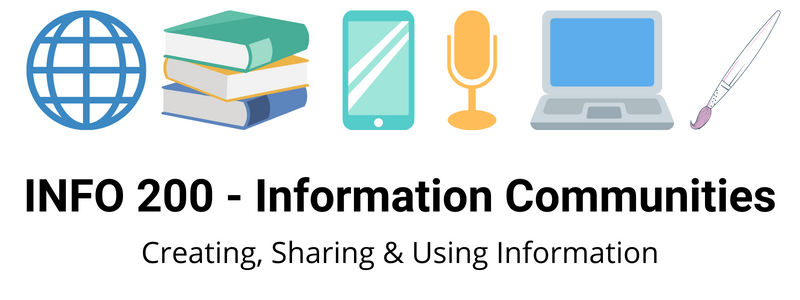Types of Information Sources:
There are three different categories of information sources that students, faculty, and other researchers use to locate data for their research projects:
- Primary sources:
- original raw data that researchers use as evidence in their scholarly and professional writing
- Examples: interviews, surveys focus groups, participant observation, and case studies
- Secondary sources:
- interpretation of some sort of research
- a literature review is based on secondary sources
- Examples: books, journal articles, or conference presentations
- Tertiary sources:
- more commonly known as reference sources
- provide a general overview of a topic when starting research
- Examples: encyclopedias, dictionaries, and even Wikipedia!
Your task this semester is to become an authority on a given information community in order to develop information services that meet that community’s information needs. This requires background research into the community’s demographics and characteristics, their information seeking behavior, and their particular information preferences and needs. As explained above, there are different types of information sources that you should consult at various stages of your research project. To use these sources effectively, you need to have a solid search strategy so that you consult the right source at the right time to get the right kind of information.
To begin researching your term paper, it is helpful to do some background reading about your community and information-seeking behavior more generally, seeking out some authoritative reference sources to see what you can learn about your topic.
Encyclopedias:
Encyclopedia entries are written by noted experts and it is the contributors’ responsibility to provide authoritative information about the topic they are writing about. There are general, sometimes called universal, encyclopedias (like Encyclopedia Britannica) that attempt to encapsulate the world’s knowledge in a multi-volume set. Then there are subject-specific encyclopedias that cover just one topic. These subject encyclopedias are sophisticated and scholarly. Often the entries are lengthy, multi-page essays with references provided at the end. A good starting place for LIS research is the Encyclopedia of Library and Information Sciences (ELIS), which is available online through the King Library catalog. In ELIS you can find authoritative essays with substantial bibliographies on a variety of topics that relate to specific information communities and information-seeking behavior generally.
Dictionaries:
There many are specialized dictionaries devoted to LIS terms, including a couple of online dictionaries that you can easily access. The most general LIS dictionary is ODLIS: Online Dictionary of Library and Information Science. ODLIS provides brief definitions of LIS terms, plus links to related terms and additional resources. There are many other LIS dictionaries that you can consult for definitions relating to specific fields. For example, The Dictionary of Archives Terminology is used by archivists and special collections librarians to understand terms related to rare books and manuscripts.
Locating Secondary Sources for your Literature Review Matrix:
Once you have done some background reading and research and have a sense of the general character of your information community, the language used to describe it, and the kinds of resources you have to work with, you are ready to see what others have written about your group. Because library and information science is a quickly changing field, its research literature is typically found in periodicals—that is, articles in scholarly and professional journals. The primary dissemination of scholarly knowledge and research in the LIS field is through the journal. Because most LIS writings are found in journals, you will usually use online databases to locate secondary sources. The King Library provides access to many databases that cover LIS publication. The INFO 200 LibGuide details the most popular LIS databases for your research.
Using Databases to Research Information Communities:
You need to be aware of the subject terms and keywords you use when doing research on your information community. Most, if not all, databases use what is called a “controlled vocabulary” or thesaurus, a predetermined list of subjects that indexers use when assigning subject headings to a book or article in the database. You will learn more about controlled vocabularies in INFO 202. Always browse the database’s list of subject terms and make note of terms used to describe your information community and its information needs. In addition, when you find a good article about your community, look at subject terms assigned to it. This will help you expand your search terms to achieve more comprehensive results. Also, depending on your information community, you might benefit from looking at databases in other disciplines and subject areas rather than relying solely on LIS sources.
Here is a video from SJSU librarian Ann Agee about using databases to research information communities:
Selecting Articles:
When selecting articles for your literature review and final paper, take care to distinguish between scholarly and professional publications and between articles that are refereed and those that are not. A “refereed” or “peer-reviewed” article has gone through an extensive editorial review process and is considered to be the most authoritative and scholarly because they have undergone this scrutiny. The editors of refereed journals send submitted articles to one or more experts on the topic who evaluate the article’s scholarship and recommend whether it should be published or not. For your INFO 200 assignments, be sure to use as many peer-reviewed articles as possible. This can be accomplished by limiting your database search results to only those articles appearing in peer-reviewed journals. On the other hand, articles published in non-scholarly, professional journals can be useful, but often do not have a list of references, a bibliography, or other scholarly components. Non-scholarly journals should be used for learning about your information community rather than as an official reference for your literature review and a final paper. Among the King Library’s databases, you’ll find Ulrich’s Periodical Directory. Ulrich’s provides a full description of current journals and magazines, including whether or not the journal is peer-reviewed. So if you are unsure if an article you’re using for an academic paper is peer-reviewed, you can always look it up in Ulrich’s to be sure.
Here is a another video from SJSU librarian Ann Agee about using Ulrich’s:
Here is a video created by Ellen Greenblatt about peer-reviewed vs. professional material:
https://www.youtube.com/watch?v=wYmun9Fh9yQ
Link to the transcript for Ellen Greenblatt’s Peer-Reviewed vs. Professional video: Peer-Reviewed vs. Professional Transcript (Links to an external site.)
Here is link that Professor Greenblatt refers to in her video above:
Conclusion:
Hopefully, this brief overview of LIS sources and how to use them whets your appetite for beginning your research on your information community. Please review the King Library’s tutorials and consider other resources listed in the INFO 200 LibGuide. You will be using these encyclopedias, dictionaries, and databases throughout your time at the School of Information and hopefully the writing assignments in this class will provide a helpful introduction. The next section introduces INFO 200 students to formatting your paper and proper APA 7 style.
Next: Module 2 Part 2: Academic Writing Conventions and Style

